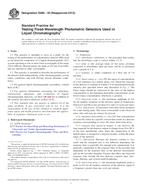Potřebujeme váš souhlas k využití jednotlivých dat, aby se vám mimo jiné mohly ukazovat informace týkající se vašich zájmů. Souhlas udělíte kliknutím na tlačítko „OK“.
ASTM D6866-12
Standard Test Methods for Determining the Biobased Content of Solid, Liquid, and Gaseous Samples Using Radiocarbon Analysis
Automaticky přeložený název:
Standardní testovací metody pro stanovení Biobased Obsah pevné, kapalné a plynné vzorky pomocí analýzy radiokarbonových
NORMA vydána dne 1.4.2012
Informace o normě:
Označení normy: ASTM D6866-12
Poznámka: NEPLATNÁ
Datum vydání normy: 1.4.2012
Kód zboží: NS-36818
Počet stran: 14
Přibližná hmotnost: 42 g (0.09 liber)
Země: Americká technická norma
Kategorie: Technické normy ASTM
Kategorie - podobné normy:
Anotace textu normy ASTM D6866-12 :
Keywords:
accelerator mass spectrometry, biobased, 14C (carbon-14), carbon dating, isotope ratio mass spectrometry, liquid scintillation counting, new carbon, old carbon, Biobased content (of materials/products), Carbon content--plastic materials, Mass spectrometry, ICS Number Code 71.040.50 (Physicochemical methods of analysis)
Doplňující informace
| Significance and Use | ||||||||||||
|
Presidential (Executive) Orders 13101, 13123, 13134, Public Laws (106-224), AG ACT 2003 and other Legislative Actions all require Federal Agencies to develop procedures to identify, encourage and produce products derived from biobased, renewable, sustainable and low environmental impact resources so as to promote the Market Development Infrastructure necessary to induce greater use of such resources in commercial, non food, products. Section 1501 of the Energy Policy Act of 2005 (Public Law 109–58) and EPA 40 CFR Part 80 (Regulation of Fuels and Fuel Additives: Renewable Fuel Standard Requirements for 2006) require petroleum distributors to add renewable ethanol to domestically sold gasoline to promote the nation's growing renewable economy, with requirements to identify and trace origin. Method B utilizes Accelerator Mass Spectrometry (AMS) along with Isotope Ratio Mass Spectrometry (IRMS) techniques to quantify the biobased content of a given product. Intsrumental error can be within 0.1-0.5 % (1 rsd), but empirical studies identify a total uncertainty up to ±3 % (absolute) inclusive of indeterminant sources of error in the final biobased content result. Sample preparation methods include the production of CO2 within a vacuum manifold system where it is ultimately distilled, quantified in a calibrated volume, transferred to a quartz tube, and torch sealed. Details are given in 8.7-8.10. The stored CO2 is then delivered to an AMS facility for final processing and analysis. Method C uses LSC techniques to quantify the biobased content of a product using sample carbon that has been converted to benzene. This test method determines the biobased content of a sample with a maximum total error of ±3 % (absolute), as does Method B. The test methods described here directly discriminate between product carbon resulting from contemporary carbon input and that derived from fossil-based input. A measurement of a product’s 14C/12C content is determined relative to the modern carbon-based oxalic acid radiocarbon Standard Reference Material (SRM) 4990c, (referred to as HOxII). It is compositionally related directly to the original oxalic acid radiocarbon standard SRM 4990b (referred to as HOxI), and is denoted in terms of fM, that is, the sample’s fraction of modern carbon. (See Terminology, Section 3.) Reference standards, available to all laboratories practicing these test methods, must be used properly in order that traceability to the primary carbon isotope standards are established, and that stated uncertainties are valid. The primary standards are SRM 4990c (oxalic acid) for 14C and RM 8544 (NBS 19 calcite) for 13C. These materials are available for distribution in North America from The National Institute of Standards and Technology (NIST), and outside North America from the International Atomic Energy Agency (IAEA), Vienna, Austria. Acceptable SI unit deviations (tolerance) for the practice of these test methods is ±5 % from the stated instructions unless otherwise noted. |
||||||||||||
| 1. Scope | ||||||||||||
|
1.1 These test methods do not address environmental impact, product performance and functionality, determination of geographical origin, or assignment of required amounts of biobased carbon necessary for compliance with federal laws. 1.2 These test methods are applicable to any product containing carbon-based components that can be combusted in the presence of oxygen to produce carbon dioxide (CO2) gas. The overall analytical method is also applicable to gaseous samples, including flue gases from electrical utility boilers and waste incinerators. 1.3 These test methods make no attempt to teach the basic principles of the instrumentation used although minimum requirements for instrument selection are referenced in the References section. However, the preparation of samples for the above test methods is described. No details of instrument operation are included here. These are best obtained from the manufacturer of the specific instrument in use. 1.4 Currently, there are no ISO test methods that are equivalent to the test methods outlined in this standard. 1.5 This standard does not purport to address all of the safety concerns, if any, associated with its use. It is the responsibility of the user of this standard to establish appropriate safety and health practices and determine the applicability of regulatory limitations prior to use. |
||||||||||||
| 2. Referenced Documents | ||||||||||||
|
Podobné normy:
Historická
1.1.2013
Historická
1.5.2011
Historická
1.1.2013
Historická
1.11.2011
Historická
1.11.2011
Historická
1.1.2013
Doporučujeme:
EviZak - všechny zákony včetně jejich evidence na jednom místě
Poskytování aktuálních informací o legislativních předpisech vyhlášených ve Sbírce zákonů od roku 1945.
Aktualizace 2x v měsíci !
Chcete vědět více informací? Podívejte se na tuto stránku.



 ASTM E516-95a(2013)..
ASTM E516-95a(2013).. ASTM E539-11
ASTM E539-11 ASTM E573-01(2013)..
ASTM E573-01(2013).. ASTM E594-96(2011)..
ASTM E594-96(2011).. ASTM E682-92(2011)..
ASTM E682-92(2011).. ASTM E685-93(2013)..
ASTM E685-93(2013)..
 Cookies
Cookies
